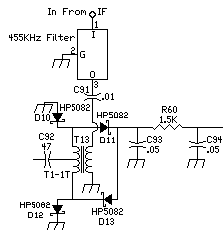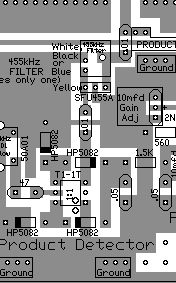



|
This circuit originally comes from "A High-Performance Receiver for 160 Meters", Solid State Design for the Radio Amateur, by Wes Hayward and Doug DeMaw, p. 136. The diode product detector was the easiest to build and gave the lowest noise output. Standard 1N914 diodes work perfect in this circuit. However, the Schottky diodes used in the receiver kit increased output and performance over the 1N914s. The output filter (1.5K resistor and two .05 caps) is critical with component type. The actual value used for the .05 mfd caps (C93 & C94) should be .047 mono caps. If .05 bypass caps are used the noise level of the receiver raises considerably. The output of the 455 kHz IF strip is fairly high, so a high gain product detector does not work well here. Also, the noise of the receiver is considerably lower with a diode product detector over an active product detector. The 455 kHz filter (L40) is a ceramic filter with a 6 kHz bandwidth and a notch at 455 kHz. It helps lower the noise output of the IF strip. SFU455As will replace the L40s when they run out. The SFU455A has a bandwidth of 10 kHz. The loss of the filters is about 6dB. Any inexpensive 455 kHz filter will work here. Two different filter footprints are provided so most of the available filters will fit on the board. |
Send E-Mail || Amateur Radio Receivers || Electroluminescent Receiver
